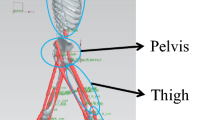Abstract
A neural network model has been developed to represent the shaping function of a central pattern generator (CPG) for human locomotion. The model was based on cadence and electromyographic data obtained from a single human subject who walked on a treadmill. The only input to the model was the fundamental timing of the gait cycle (stride rate) in the form of sine and cosine waveforms whose period was equal to the stride duration. These simple signals were then shaped into the respective muscle activation patterns of eight muscles of the lower limb and trunk. A network with a relatively small number of hidden units trained with back-propagation was able to produce an excellent representation of both the amplitude and timing characteristics of the EMGs over a range of walking speeds. The results are further discussed with respect to the dependence of some muscles upon sensory feedback and other inputs not explicitly presented to the model.
Similar content being viewed by others
Author information
Authors and Affiliations
Additional information
Received: 9 February 1998 / Accepted: 13 August 1998
Rights and permissions
About this article
Cite this article
Prentice, S., Patla, A. & Stacey, D. Simple artificial neural network models can generate basic muscle activity patterns for human locomotion at different speeds. Exp Brain Res 123, 474–480 (1998). https://doi.org/10.1007/s002210050591
Issue Date:
DOI: https://doi.org/10.1007/s002210050591




